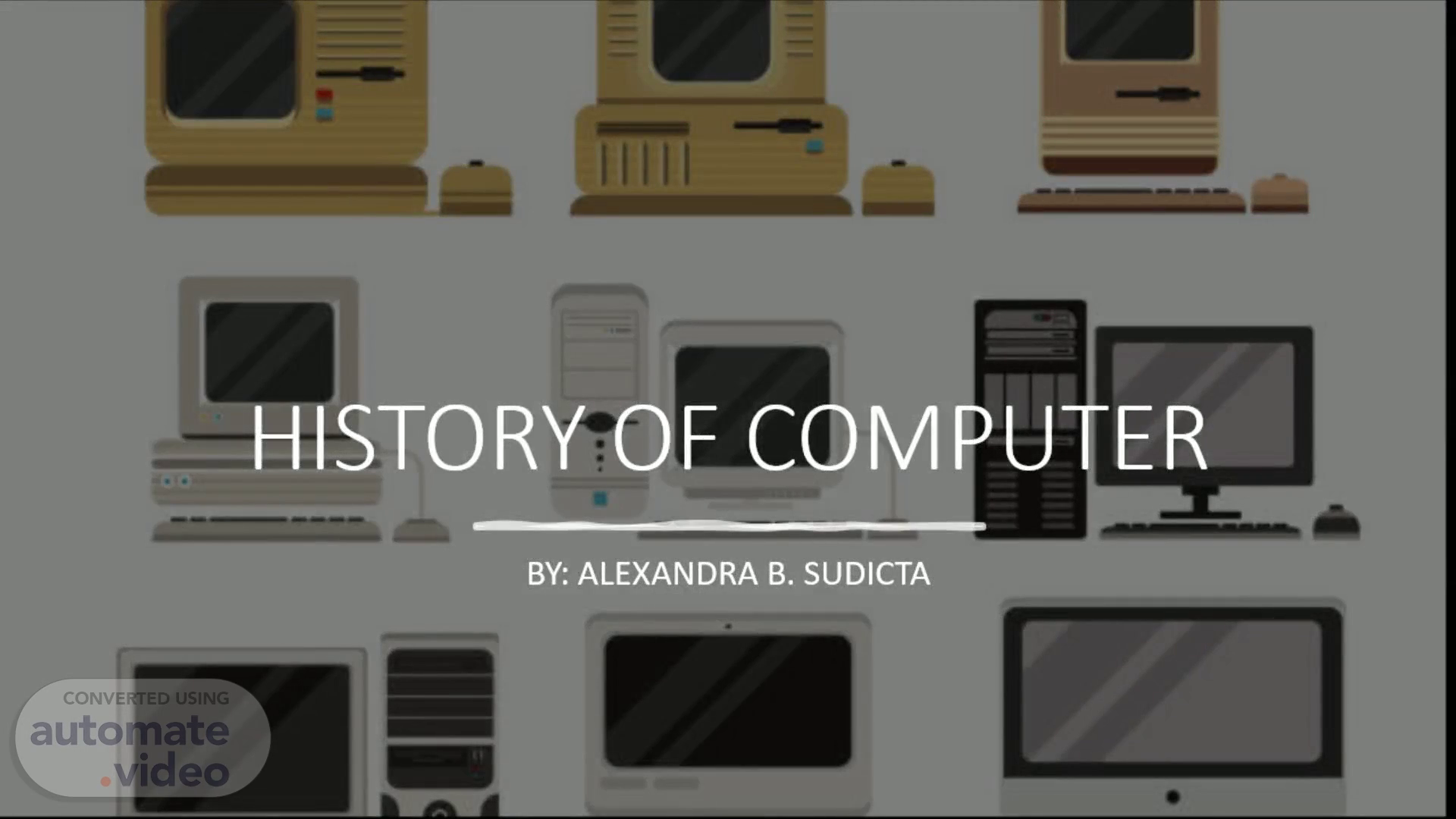Scene 1 (0s)
[Audio] HISTORY OF COMPUTER. A picture containing text Description automatically generated.
Scene 2 (9s)
BACKGROUND The word "computer" was first used in 1613 in the book The Yong Mans Gleanings by Richard Braithwaite and originally described a human who performed calculations or computations..
Scene 3 (20s)
[Audio] DEFINITION OF COMPUTER A computer is an electronic machine that collects information, stores it, processes it according to user instructions, and then returns the result..
Scene 4 (33s)
[Audio] FATHER OF COMPUTER Charles Babbage, who was born in 1791, is regarded as the father of computing because of his research into machines that could calculate. Babbage's Difference Engine Number 1 was the first device ever devised that could calculate and print mathematical tables..
Scene 5 (54s)
[Audio] JOSEPH-MARIE JACQUARD Jacquard Loom 1801: He played an important role in the development of the earliest programmable loom (the " Jacquard loom"), which in turn played an important role in the development of other programmable machines, such as an early version of digital compiler used by IBM to develop the modern day computer..
Scene 6 (1m 17s)
[Audio] CHARLES BABBAGE Difference Engine 1821: Babbage invented the Difference Engine to compile mathematical tables. On completing it in 1832, he conceived the idea of a better machine that could perform not just one mathematical task but any kind of calculation..
Scene 7 (1m 38s)
[Audio] ADA LOVELACE First programmable computing machine 1848: Ada Lovelace, an English mathematician and the daughter of poet Lord Byron, writes the world's first computer program. She was the first to recognize that the machine had applications beyond pure calculation, and created the first algorithm intended to be carried out by such a machine..
Scene 8 (2m 3s)
[Audio] GEORG SCHEUTZ First Printing Calculator 11853: Swedish inventor Per Georg Scheutz and his son Edvard design the world's first printing calculator..
Scene 9 (2m 19s)
[Audio] HERMAN HOLLERITH Computer punch cards 1890: Herman Hollerith is widely regarded as the father of modern automatic computation. He chose the punched card as the basis for storing and processing information and he built the first punched-card tabulating and sorting machines as well as the first key punch, and he founded the company that was to become IBM..
Scene 10 (2m 45s)
[Audio] VANNEVAR BUSH The differential analyzer 1931: Vannevar Bush an American electrical engineer and administrator who developed the Differential Analyzer and oversaw government mobilization of scientific research during World War II..
Scene 11 (3m 5s)
[Audio] ALAN TURING Bombe 1936: Turing's most notable work today is as a computer scientist. In 1936, he developed the idea for the Universal Turing Machine, the basis for the first computer. And he developed a test for artificial intelligence in 1950, which is still used today. But he also studied physics, especially as a young man..
Scene 12 (3m 35s)
[Audio] JOHN VINCENT ATANASOFF Atanasoff–Berry computer 1937: John Vincent Atanasoff, a professor of physics and mathematics at Iowa State University, submits a grant proposal to build the first electric-only computer, without using gears, cams, belts or shafts..
Scene 13 (3m 56s)
[Audio] KONRAD ZUSE Z3 1941: German inventor and engineer Konrad Zuse completes his Z3 machine, the world's earliest digital computer..
Scene 14 (4m 11s)
[Audio] ATANASOFF AND CLIFFORD BERRY Atanasoff-Berry Computer 1941: Atanasoff and his graduate student, Clifford Berry, design the first digital electronic computer in the U.S., called the Atanasoff-Berry Computer ( ABC)..
Scene 15 (4m 31s)
[Audio] ATANASOFF AND CLIFFORD BERRY Atanasoff-Berry Computer 1945: Two professors at the University of Pennsylvania, John Mauchly and J. Presper Eckert, design and build the Electronic Numerical Integrator and Calculator ( ENIAC)..
Scene 16 (4m 50s)
[Audio] WILLIAM SHOCKLEY JOHN BARDEEN AND WALTER BRATTAIN Transistor Effect 1947: William Shockley, John Bardeen and Walter Brattain of Bell Laboratories invent the transistor. They discover how to make an electric switch with solid materials and without the need for a vacuum..
Scene 17 (5m 13s)
[Audio] Electronic Delay Storage Automatic Calculator 1949: A team at the University of Cambridge develops the Electronic Delay Storage Automatic Calculator ( EDSAC), "the first practical stored-program computer," according to O'Regan. "EDSAC ran its first program in May 1949 when it calculated a table of squares and a list of prime numbers," O'Regan wrote..
Scene 18 (5m 40s)
[Audio] GRACE HOPPER Cobol 1953: Grace Hopper develops the first computer language, which eventually becomes known as COBOL, which stands for COmmon, Business-Oriented Language. Hopper is later dubbed the " First Lady of Software" in her posthumous Presidential Medal of Freedom citation..
Scene 19 (6m 2s)
[Audio] JOHN BACKUS ForTran 1954: John Backus and his team of programmers at IBM publish a paper describing their newly created FORTRAN programming language, an acronym for FORmula TRANslation, according to MIT(opens in new tab)..
Scene 20 (6m 22s)
[Audio] JOHN BACKUS Computer chip 1958: Jack Kilby and Robert Noyce unveil the integrated circuit, known as the computer chip. Kilby is later awarded the Nobel Prize in Physics for his work..
Scene 21 (6m 40s)
[Audio] DOUGLAS ENGELBART Mouse 1968: Douglas Engelbart he was trying to figure out better ways to operate computers and graphical user interfaces. As such, he developed the mouse. The first version was actually a wooden device that came on two wheels and was attached to the computer via a wire..
Scene 22 (7m 5s)
[Audio] Dennis Ritchie and Ken Thompson UNIX 1969: Dennis Ritchie and Ken Thompson invented Unix, arguably the world's most important computer operating system..
